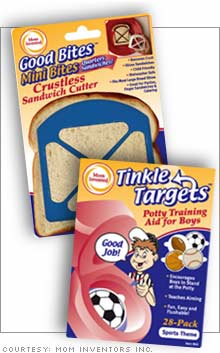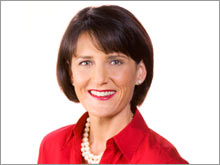 |
| Tinkle Targets and the crustless sandwich cutter: Two offerings from Mom Inventors |
|
 |
| Mom Inventors CEO and founder Tamara Monosoff |
|
|
|
|
|
NEW YORK (CNN/Money) -
You don't have to come up with the steam engine, the light bulb or the microprocessor to make a splash in the inventing world.
Sometimes all you have to do is encourage others to make a splash.
Take, for example, the "Tinkle Target." A picture of a sports item or toy truck that is affixed to the bottom of a toilet bowel, the Tinkle Target helps teach little boys how to hit the mark.
It's an invention born of necessity and sold by Mom Inventors Inc., a California company that helps aspiring inventors turn their ideas into products.
The company was founded three years ago by 40 year-old Tamara Monosoff after the mother of three invented the "TP Saver," essentially a rubber band that secures the roll of toilet paper and denies children or pets the joy of unraveling it into an unruly mess.
Monosoff said she had a hard time finding resources that would help her with both the creative and business side of inventing. So she set up a Web site (www.mominventors.com) and soon had submissions pouring in for both ideas and advice.
Mom Inventors now has twelve products, including a sandwich cutter, shoe stickers to teach kids right from left and clear plastic tablecloth covers, with projected sales of $1 million to $2 million next year.
Now Monosoff has put her knowledge on paper, authoring the Mom Inventors Handbook, a how-to resource guide for aspiring Thomas Edisons that lays out the inventing process from conception and patenting to marketing and financing.
Contrary to popular belief, Monosoff says the importance of the patent is one of the first things inventors should get over.
"This is not an invention, it's a product," she said. "You need to put on your business hat."
Monosoff said companies are only interested in inventions that sell, so they are unlikely to rip off your idea before it actually hits the shelves.
She also said rivals only have to make a copy of your product that is 10 percent different from the patent, rendering the legal protection "pretty useless.
"Don't worry about your competitor," she said. "Just get your product out there."
Creating prototypes
Monosoff says to certainly create a prototype of your gizmo or gadget before you speak to an engineer, manufacturer or distributor. It can be made out of old water bottles and sting and certainly doesn't need to be pretty, but if the thing doesn't work, it's not going to sell.
She said she found an engineer to refine her TP Saver in the yellow pages and has stuck with him since. Nowadays, there exists a Web site, thomasnet.com, where you can type in the material you're working with and the state you're in and get a list of prototype developers.
Protecting your invention
While a patent isn't a necessity, Monosoff says to document every stage of your creative process in a notebook. If two or more products come to market at the same time and there is a trademark fight, she says, the patent office will ask to see those notebooks in determining who started work first.
If you're trying to get a manufacturer to buy your invention, never send them the specifics without first having them sign a non-disclosure agreement, especially if you don't hold a patent.
How to pay for it
When it comes to funding there are lots of different options. Monosoff suggests using your own savings or home equity first, or tap family and friends.
But if you prefer gambling with someone else's money, she says the Small Business Association has a loan program and the Web site www.microenterpriseworks.org is a great resource center.
"The funding is so accessible," she says. "You just have to know where to look for it."
Finding someone to make it
This can be the trickiest part of the process, since most manufacturing is done overseas and there is the language barrier as well as logistical concerns.
Monosoff says the Chamber of Commerce is a great place to start, as they can help identify manufacturers and liaisons.
Try to arrange to see a sample of your product before you commit to a full production run.
Now sell it
Big bucks aren't required to get your product to market.
Monosoff suggests starting small at your local retailers. Trade shows are also a good place to start, as "there's a trade organization for everything."
When you're ready for the big time, she suggests utilizing Web sites like Hoovers.com were you can get ahold of the management list for every corporation and send pitches directly to them. Or prweb.com, which will allow you to send out your own press releases.
______________________________________
Got an idea for a new sport? Click here.

|